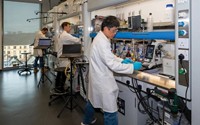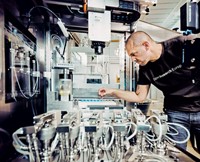Advertisement
Grab your lab coat. Let's get started
Welcome!
Welcome!
Create an account below to get 6 C&EN articles per month, receive newsletters and more - all free.
It seems this is your first time logging in online. Please enter the following information to continue.
As an ACS member you automatically get access to this site. All we need is few more details to create your reading experience.
Not you? Sign in with a different account.
Not you? Sign in with a different account.
ERROR 1
ERROR 1
ERROR 2
ERROR 2
ERROR 2
ERROR 2
ERROR 2
Password and Confirm password must match.
If you have an ACS member number, please enter it here so we can link this account to your membership. (optional)
ERROR 2
ACS values your privacy. By submitting your information, you are gaining access to C&EN and subscribing to our weekly newsletter. We use the information you provide to make your reading experience better, and we will never sell your data to third party members.
Instrumentation
AI and robotics come together for synthesis
SRI’s SynFini system integrates machine learning with automated flow chemistry
by Craig Bettenhausen
January 29, 2020
| A version of this story appeared in
Volume 98, Issue 5

AI-assisted synthesis planning is on the march. Flow chemistry is maturing and scaling up. Now the race is on to bring the two together.
At this week’s Society for Lab Automation and Screening conference in San Diego, the research nonprofit SRI International unveiled SynFini, which it describes as a “fully automated, end-to-end synthetic chemistry system.”
The biggest target market for the platform is drug discovery and development, a space SRI has played in for decades. But SynFini was developed in part with funding from the US Defense Department’s DARPA agency, which is interested in automated synthesis for applications including explosives, polymers, and bioterrorism countermeasures. “We can access virtually any chemistry we set our mind to,” SRI Chief Strategy Officer Nathan Collins says.
SynFini combines three main components: AI-assisted synthetic route design software, an inkjet-based µg- to mg-scale screening and optimization module, and a mg- to kg-scale flow chemistry platform.
The system is still in “beta,” Collins says. SRI uses it in-house on drug leads including for cancer, wound healing, and the flu and on fee-for-service programs with outside clients. Collins says SRI is still working on the business model for SynFini, and a decision on whether or not to offer it as a stand-alone product is a few years off.
Academic researchers are working on similar systems. “Connecting synthesis planning, reaction screening and optimization, and multistep synthesis is a great way to accelerate chemical development,” says Connor Coley, a postdoc at the Broad Institute of MIT and Harvard. Coley was first author on a 2019 Science paper detailing an AI-informed robotic flow chemistry system being developed at MIT (DOI: 10.1126/science.aax1566).
The same DARPA program, “Make-it,” that funded both the MIT and SRI projects also supported the development of Chematica, a synthesis planning software developed by chemist Bartosz Grzybowski and later acquired by MilliporeSigma, which markets it as Synthia. Grzybowski recently published an algorithm that allows Chematica to avoid synthetic methods currently under patent protection.




Join the conversation
Contact the reporter
Submit a Letter to the Editor for publication
Engage with us on Twitter